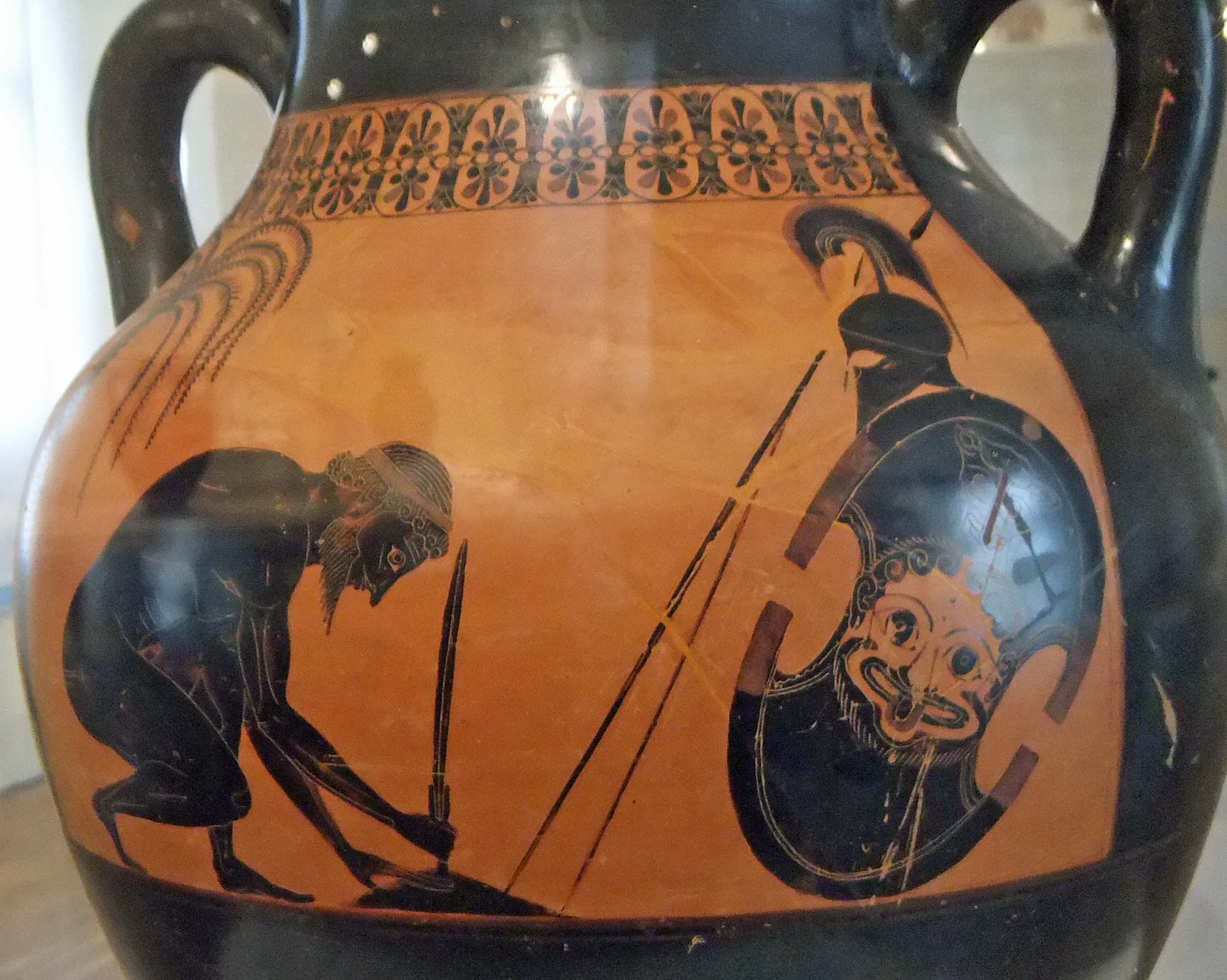Suicide of Ajax vase on:
[Wikipedia]
[Google]
[Amazon]
 The Suicide of Ajax Vase depicting the suicide of
The Suicide of Ajax Vase depicting the suicide of
 The Suicide of Ajax Vase depicting the suicide of
The Suicide of Ajax Vase depicting the suicide of Ajax
Ajax may refer to:
Greek mythology and tragedy
* Ajax the Great, a Greek mythological hero, son of King Telamon and Periboea
* Ajax the Lesser, a Greek mythological hero, son of Oileus, the king of Locris
* ''Ajax'' (play), by the ancient Gree ...
is a neck amphora, painted in the black-figure
Black-figure pottery painting, also known as the black-figure style or black-figure ceramic ( grc, , }), is one of the styles of painting on antique Greek vases. It was especially common between the 7th and 5th centuries BCE, although there are ...
style. It is now in the Château-musée de Boulogne-sur-Mer
Boulogne-sur-Mer (; pcd, Boulonne-su-Mér; nl, Bonen; la, Gesoriacum or ''Bononia''), often called just Boulogne (, ), is a coastal city in Northern France. It is a sub-prefecture of the department of Pas-de-Calais. Boulogne lies on the C ...
in France. The painter was Exekias
Exekias ( grc, Ἐξηκίας, ''Exēkías'') was an ancient Greek vase painter and potter who was active in Athens between roughly 545 BC and 530 BC. Exekias worked mainly in the black-figure technique, which involved the painting of scen ...
, who made this work in Athens
Athens ( ; el, Αθήνα, Athína ; grc, Ἀθῆναι, Athênai (pl.) ) is both the capital and largest city of Greece. With a population close to four million, it is also the seventh largest city in the European Union. Athens dominates ...
at the end of the Archaic Period, around 530 BC. The scene shows Ajax
Ajax may refer to:
Greek mythology and tragedy
* Ajax the Great, a Greek mythological hero, son of King Telamon and Periboea
* Ajax the Lesser, a Greek mythological hero, son of Oileus, the king of Locris
* ''Ajax'' (play), by the ancient Gree ...
preparing for his suicide, a unique scene in Ancient Greek art. Black-figure is a technique for pottery decoration where the painter would paint the figures in black paint and leave the background as unpainted clay. Ajax appears in the middle, bent over his sword which he is placing in the ground. There is a tree to one side of him and his suit of armor to the other side. There is a line of geometric decoration at the top of the scene and at the bottom of the amphora.
Exekias
Exekias
Exekias ( grc, Ἐξηκίας, ''Exēkías'') was an ancient Greek vase painter and potter who was active in Athens between roughly 545 BC and 530 BC. Exekias worked mainly in the black-figure technique, which involved the painting of scen ...
is a well-known Greek artist. He put images of the Trojan War
In Greek mythology, the Trojan War was waged against the city of Troy by the Achaeans (Greeks) after Paris of Troy took Helen from her husband Menelaus, king of Sparta. The war is one of the most important events in Greek mythology and ...
, and Ajax in particular, on his work quite often. Ajax appears on his work more than any other Greek artist's work. Ajax was supposedly born on the island of Salamis, which is where Exekias is believed to be from. Some scholars infer that this connection is one of the reasons Exekias chooses to depict Ajax so often. Exekias is known for being able to show tension and emotion in scenes very well.
Myth
Ajax was considered the second-best hero at Troy, after his cousinAchilles
In Greek mythology, Achilles ( ) or Achilleus ( grc-gre, Ἀχιλλεύς) was a hero of the Trojan War, the greatest of all the Greek warriors, and the central character of Homer's '' Iliad''. He was the son of the Nereid Thetis and Pele ...
. Once Achilles dies, Ajax and Odysseus debate over who should receive his armor. When Odysseus is given the armor, Ajax goes mad. He kills Greek cattle believing that it is the Greeks. Once he becomes aware of what he has done, he commits suicide. Ajax believes that after the cattle incident, killing himself is the only way to keep his status as a hero and to avoid bringing shame to his noble father Telamon
In Greek mythology, Telamon (; Ancient Greek: Τελαμών, ''Telamōn'' means "broad strap") was the son of King Aeacus of Aegina, and Endeïs, a mountain nymph. The elder brother of Peleus, Telamon sailed alongside Jason as one of his Argo ...
.
Details
Most scenes in Greek art are the climax of a story, such as battles and other active subjects. However, Exekias chooses to show Ajax preparing for his suicide, which no other known images of this event do. There are other representations of Ajax's suicide, including a Middle Protocorinthianaryballos
An aryballos ( Greek: ἀρύβαλλος; plural aryballoi) was a small spherical or globular flask with a narrow neck used in Ancient Greece."aryballos" in ''The New Encyclopædia Britannica''. Chicago: Encyclopædia Britannica Inc., 15th edn., ...
, an Athenian ivory comb, and sixth century Corinthian vases. All of these show Ajax once he has already done the act of falling on his sword. Exekias shows Ajax planting his sword in the ground. He is nude, which shows his vulnerability in this moment. A single palm tree adds to the isolation of the scene.
References
{{reflist Amphorae 6th century BC in Greece